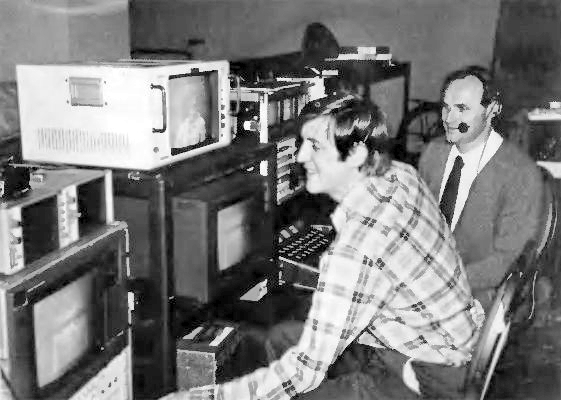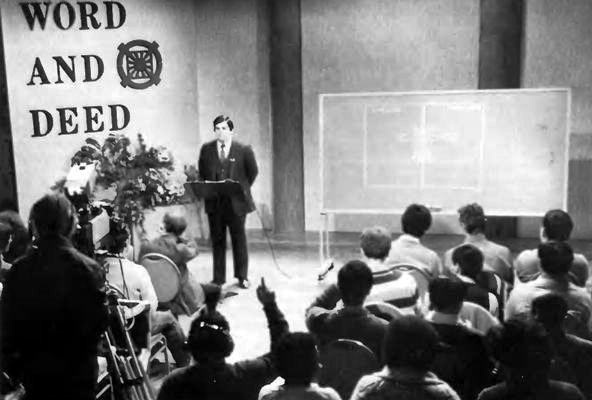![]()
The Words of the Reno Family
|
|
The Words of the Reno Family |

Edward
Reno, Technical Director and Ron Paquette, Director, at work.
The Terrace Room of the World Mission Center is filled with a blaze of light and the murmurings of hundreds of voices. "Camera three, pan right and zoom in slowly." "Stand by, Kevin's mike." "Stand by, cue Kevin. Ready, camera one. Dissolve to -- one, cue Kevin." A man wearing headsets crouching in the audience jabs his finger toward Kevin McCarthy.
"Welcome, everybody." A warm smile spreads across Kevin McCarthy's face. "Welcome to our first lecture on the Divine Principle, the first in a series of programs called Word and Deed. Tonight we will discuss...."
If you have never heard the term "Electronic Church" before, you might think of something that would appear in a model train set. In reality the idea is much more than that. It began with the early days of black and white television, when Bishop Fulton Sheen addressed millions of people every Wednesday night using a blackboard to illustrate his points. Since then hundreds of others, such as Robert Schuller, have used television to broadcast their understandings of God's word. Many Unification Church members have envisioned the day when Father's message would be broadcast to millions of people. Now it seems we are one step closer to that goal.
In early 1983, at a leaders' conference, Father asked for information about cable TV -- was there any way to use it in our witnessing providence? This created a broad groundswell of research and as the facts came in, a picture began to emerge.
Cable TV is a commercial industry which began in the 1960s. It was originally used in areas where normal television reception was of poor quality, due to distance from the aerial or a large natural obstacle (such as a mountain) between the broadcast tower and the home viewer. Commercial companies would put antennas high on a mountain or other structure to capture strong TV signals and then run a cable into each customer's home, hook it up to the television set, and charge rent. In this way cable TV began in small pockets across the United States.
However, large broadcasters, such as NBC or CBS or ABC, soon complained. They claimed that because they were putting out their television signals for free, it was unfair that cable companies could use the signals to make money. The Federal Communication Commission (FCC) decided that cable companies could continue, but would be obliged to provide a special service, known as Local Origination, to the communities they supplied. The cable companies were to originate television programs concerning community activities in their cable area, at no cost to the local subscribers or community. This would provide cable subscribers with information about their own areas and help keep them in touch with their neighborhoods and cities. In the early 1970s people were tremendously excited about cable TN. Television was no longer a one way street of mass marketing. Instead it fostered the relationship between communities and the people with a need to reach the public in an immediate way, such as political groups and community service programs. For a while cable TV was hailed as the "new television community messiah," and many thought cable TN would revolutionize the American way of life.
In the early seventies the FCC changed its ruling, and cable companies only had to provide access to the cable at no cost to the public, and local communities had to produce their own programs. Communities were slow to respond. As the old saying goes, all that is needed for the forces of evil to succeed is for enough good men to do nothing. First-run movies appeared with the ultimate goal of having a continuous pornography channel in every home. Fortunately that idea did not take hold. H130 and Cinemax, which in the early days showed X-rated movies, today restrict their programs to nothing below an R rating.
God's forces are now beginning to group for an assault on the public access frontier in America's largest city, New York. Manhattan Cable TV and Group W sponsor a channel solely for the New York City municipal government, one for New York University, and two channels on which local productions can air their programs for free (Channels C and D). During prime time, 7:00-10:00 p.m., these channels are filled with programs created by civic groups, community organizations, political groups, special interest groups, and of course, churches. Manhattan's cable companies have a combined subscribership of over two hundred thousand New Yorkers.

When Rev. Ken Sudo became the Director of New York Church earlier this year, he initiated a telephone witnessing campaign. This facility could provide a base for cable TV outreach as well. The number of the telephone witnessing center would be announced on the program, and viewers could then contact members for more information.
Father approved the project, to be carried out under Rev. Chung Hwan Kwak's guidance. Contracts were immediately signed with the cable TV companies. The first "air date" was less than four weeks away, leaving little time to plan and produce the series of 52 half-hour programs.
As Executive Producer, Rev. Chung Hwan Kwak worked closely with Rev. Ken Sudo (Director of Promotions and Outreach) and Rev. David Hose (Producer) to assemble talented individuals from different departments. They chose Ron Paquette, director of the film "People of the Quest," as Director; Edward Reno as Technical Director; Larry Parker as Production Assistant; Kokichi Tachibana as Engineer; and Klaus Gunther as Lighting Director. The camera operators included Joan Groom, Edward Alleyne, and Jim Casola. Doug Williams constructed the set. II Sung members worked under an incredibly short three day deadline to make the necessary technical changes in the Terrace Room to facilitate the production.
Kevin McCarthy of the Education Department agreed to be the Lecturer. Shirley Stadelhofer and Georgia Lewis were asked to be the program's hostesses. All these individuals worked across department lines like a group of seasoned professionals. The first program was completed only a few days before the deadline.
The program, entitled "Word and Deed: The Unification Movement Towards the Ideal World," is a half-hour show comprised of two parts. The first part is a ten minute interview, conducted by Shirley Stadelhofer or Georgia Lewis, with various spokespersons from Father's humanitarian and educational projects. The second part is a twenty minute lecture on the content of Divine Principle.
We can certainly look forward to the day when there will be Unification programs broadcast nationwide, perhaps even with Father himself speaking on our own weekly program. State, CARP and IOWC leaders may now initiate the program in their own areas. Electronic church is something that must and certainly will develop.